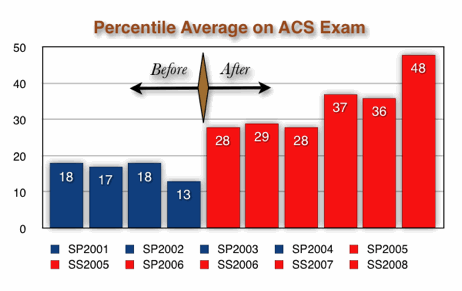A Guide to Organic Chemistry Mechanisms
Student Performance
The graph below shows student performance before and after introduction of A Guide to Organic Chemistry Mechanisms in a two semester organic chemistry class. The chart measures the class percentile average on the ACS Standardized Examination for Organic Chemistry. A Guide to Organic Chemistry Mechanisms was introduced as worksheets in 2005 and in the current workbook form in 2006.
Since introduction of the book (in worksheet format), the top students have ranked above the 75th percentile and the lower students generally above the 10th percentile. In 2005, the top student was at the 95th percentile. However, we think the greater effect on the average was to incrementally improve every student's score. In order to do that on the ACS Standardized Examination for Organic Chemistry, students needed to have the tools to solve chemical reaction problems. While it is not possible to force students to forsake shear memorization as a learning technique, we used A Guide to Organic Chemistry Mechanisms as a tool to enable students to learn reaction mechanisms. Reaction mechanisms were a staple of quiz and examination problems. As a result, we noted an increase in the number of students that wrote reaction mechanisms and intermediates for reactions, even if a mechanism was not required. That is, there was anecdotal evidence that students were using mechanistic thinking to solve new problems and we think the results on the ACS exam prove the effectiveness of that effort. Students had more tools to solve more problems.
We cannot guarantee that a student or a class will achieve the same results we achieved. Our teaching had undergone numerous changes in efforts to improve our overall student results. If you are interested in learning all that we did, write to us.